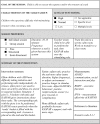How to Implement Robots in Interventions for Children with Autism? A Co-creation Study Involving People with Autism, Parents and Professionals
- PMID: 28685411
- PMCID: PMC5602062
- DOI: 10.1007/s10803-017-3235-9
How to Implement Robots in Interventions for Children with Autism? A Co-creation Study Involving People with Autism, Parents and Professionals
Abstract
The aim of this study was to gain insight into how robots can be practically implemented into current education and therapy interventions for children with autism spectrum disorder (ASD). This qualitative study included focus groups and co-creation sessions. 73 Participants (professionals and adults with ASD) took part in 13 focus groups to elicit requirements for robot assisted interventions. Additionally, 22 participants (professionals, parents of children with ASD and adults with ASD) generated ideas for interventions using robot KASPAR in three co-creation sessions. This study resulted in: an overview of requirements concerning the robot, end-user, environment and practical implementation; a template to systematically describe robot interventions in general and for KASPAR in particular; and finally new interventions.
Keywords: Autism; Co-creation; Implementation; KASPAR; Requirements; Robot; Robot assisted intervention; Robot mediated intervention.
Conflict of interest statement
Conflict of interest
The authors declare that they have no conflict of interest.
Ethical Approval
All procedures performed in studies involving human participants were in accordance with the ethical standards of the institutional and/or national research committee and with the 1964 Helsinki declaration and its later amendments or comparable ethical standards.
Informed Consent
Informed consent was obtained from all individual participants included in the study.
Figures











References
-
- Begum M, Serna RW, Yanco HA. Are robots ready to deliver autism interventions? A comprehensive review. International Journal of Social Robotics. 2016;8(2):157–181. doi: 10.1007/s12369-016-0346-y. - DOI
-
- Boucenna S, Narzisi A, Tilmont E, Muratori F, Pioggia G, Cohen D, Chetouani M. Interactive technologies for autistic children: A review. Cognitive Computation. 2014;6(4):722–740. doi: 10.1007/s12559-014-9276-x. - DOI
-
- Cabibihan J, Javed H, Ang M, Aljunied S. Why robots? A survey on the roles and benefits of social robots in the therapy of children with autism. International Journal of Social Robotics. 2013;5(4):593–618. doi: 10.1007/s12369-013-0202-2. - DOI
-
- Costa S, Lehmann H, Dautenhahn K, Robins B, Soares F. Using a humanoid robot to elicit body awareness and appropriate physical interaction in children with autism. International Journal of Social Robotics. 2015;7(2):265–278. doi: 10.1007/s12369-014-0250-2. - DOI
-
- Costa, S., Lehmann, H., Robins, B., Dautenhahn, K., & Soares, F. (2013). ”Where is your nose?”: developing body awareness skills among children with autism using a humanoid robot. ACHI 2013, The Sixth International Conference on Advances in Computer-Human Interactions, pp. 117–122.
MeSH terms
Grants and funding
LinkOut - more resources
Full Text Sources
Other Literature Sources

